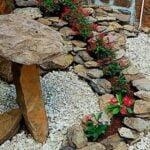Are you looking for creative ways to enhance your outdoor space? Look no further than landscaping ideas with cinder blocks. Cinder blocks are a versatile and affordable material that can be used in various ways to elevate the aesthetic appeal of your garden or backyard. From raised garden beds to stylish outdoor furniture, the possibilities are endless when it comes to incorporating cinder blocks into your landscaping projects.
One of the key benefits of using cinder blocks for landscaping is their durability and affordability. Not only are they able to withstand harsh weather conditions, but they also offer a cost-effective solution for creating stunning outdoor features. Additionally, their ease of customization allows for endless design possibilities, making them an ideal choice for DIY enthusiasts and professional landscapers alike.
In this article, we will delve into the different ways you can use cinder blocks to enhance your outdoor space. From creating raised garden beds and building retaining walls to designing pathways and walkways, we will provide you with step-by-step guides and innovative ideas that will inspire you to get creative with cinder blocks in your landscaping endeavors.
Whether you have a large backyard or a small outdoor area, there is something for everyone in our exploration of the beauty and versatility of landscaping with cinder blocks.
Benefits of Using Cinder Blocks for Landscaping
Cinder blocks, also known as concrete masonry units (CMUs), are a fantastic and versatile material for landscaping projects. Not only are they durable and affordable, but they also offer endless opportunities for customization to suit your specific design needs. Whether you’re creating raised garden beds, building retaining walls, or designing unique outdoor furniture and pathways, cinder blocks provide a solid foundation for your landscaping endeavors.
Here are some of the key benefits of using cinder blocks for your landscaping projects:
- Durability: Cinder blocks are known for their exceptional strength and longevity, making them an ideal choice for outdoor use. They can withstand various weather conditions and maintain their structural integrity over time, ensuring that your landscaping features remain sturdy and reliable.
- Affordability: One of the most attractive aspects of using cinder blocks is their cost-effectiveness. Compared to other building materials, such as natural stone or brick, cinder blocks are typically more budget-friendly while still offering excellent performance and aesthetic appeal.
- Ease of Customization: With cinder blocks, you have the freedom to create custom designs that reflect your personal style and preferences. Whether you want to paint the blocks in different colors, stack them in unique patterns, or incorporate decorative elements, such as mosaic tiles or planters, the possibilities for customization are virtually endless.
Incorporating cinder blocks into your landscaping design provides a great opportunity to unleash your creativity and make a statement in your outdoor space. From practical structures like retaining walls to artistic elements like vertical gardens, these versatile building blocks offer an array of possibilities for enhancing the beauty and functionality of your landscape.
Creating Raised Garden Beds
Creating a raised garden bed using cinder blocks is a fantastic way to add a touch of elegance and functionality to your outdoor space. These versatile building materials offer the perfect combination of durability and visual appeal, making them an excellent choice for creating raised garden beds. By following a few simple steps, you can easily build a stunning raised garden bed that will enhance the beauty of your landscaping.
Choosing the Right Location
Before you begin constructing your raised garden bed, it’s essential to select the perfect location for it in your outdoor space. Look for a spot that receives plenty of sunlight and has good drainage to ensure the health and vitality of your plants. Clear away any debris and level the ground as much as possible before proceeding with the construction.
Assembly Process
To create your raised garden bed, start by laying out the first layer of cinder blocks in a rectangular or square shape according to your desired dimensions. Once the first layer is in place, stack additional layers on top, staggering the blocks to create a sturdy structure. Use a level to ensure that each layer is even and secure, adding or removing soil as needed to adjust the height.
Planting and Maintenance
Once your raised garden bed is constructed, fill it with nutrient-rich soil and begin planting your favorite flowers, vegetables, or herbs. Regular maintenance such as watering, fertilizing, and weeding will help keep your plants healthy and thriving. Consider adding mulch around the base of your plants to retain moisture and deter weed growth. With proper care, your cinder block raised garden bed will provide years of beauty and enjoyment in your outdoor space.
By following this step-by-step guide, you can create a stunning raised garden bed using cinder blocks that will be sure to enhance the beauty and functionality of your landscaping design. Whether you’re an experienced gardener or just starting out with gardening projects, this versatile landscaping idea is suitable for all skill levels.
Building Retaining Walls
Building a retaining wall with cinder blocks can not only add structure to your landscaping but also create a visually appealing focal point in your outdoor space. The durability and affordability of cinder blocks make them an excellent choice for constructing retaining walls. Here’s a step-by-step guide to help you build a functional and stylish retaining wall using cinder blocks:
Step 1: Planning and Preparation
Before you begin, it’s essential to plan the layout and design of your retaining wall. Determine the area where the wall will be built and mark the boundaries. Consider any necessary drainage requirements to prevent water buildup behind the wall. Additionally, gather all the necessary materials and tools, including cinder blocks, gravel, leveling sand, concrete adhesive, and a shovel.
Step 2: Excavation and Foundation
Start by excavating the area where the first row of cinder blocks will be placed. Dig a trench that is at least as wide as the cinder block and deep enough to accommodate a solid foundation. Fill the trench with gravel and compact it firmly to create a stable base for the first row of blocks.
Step 3: Building the Wall
Lay the first row of cinder blocks on top of the gravel foundation, ensuring they are level from front to back and side to side. Use a rubber mallet to tap each block into place. Apply concrete adhesive between each row as you build upward for extra stability. As you continue building additional rows, stagger the placement of the blocks for added strength and visual interest.
By following these steps, you can construct a sturdy and visually appealing retaining wall using cinder blocks, enhancing both the functionality and aesthetic appeal of your landscaping project.
DIY Outdoor Furniture
If you are looking for a budget-friendly and creative way to furnish your outdoor space, consider transforming cinder blocks into stylish and functional furniture pieces. The versatility of cinder blocks allows you to create a wide range of furniture items, from seating to tables, and even planters. With some basic tools and materials, you can easily customize these DIY outdoor furniture pieces to fit your personal style and outdoor decor.
Seating Options
One popular use of cinder blocks in outdoor furniture is creating sturdy and durable seating options. By stacking cinder blocks horizontally and vertically, you can construct benches, chairs, or even lounge areas. To add comfort and style, consider adding cushions or foam padding to the seating surface. Additionally, you can incorporate wooden beams or planks as backrests or armrests for a more polished look.
Tables and Countertops
Cinder blocks can also be utilized to construct functional tables and countertops for your outdoor space. By stacking the blocks in various configurations, you can create multi-level tables for dining or displaying plants. For a sleek finish, consider laying down flat stones or wooden panels on top of the cinder block structure. This will not only provide a smooth surface but also add an elegant touch to your outdoor furniture.
Planters and Shelving
Another innovative way to use cinder blocks in outdoor furniture is by incorporating them into planters and shelving units. You can stack the blocks in different patterns to create unique planters that serve as both functional containers for greenery and decorative elements for your patio or garden. Similarly, arranging cinder blocks in a staggered formation can result in versatile shelving units that offer storage space for gardening tools or display areas for potted plants.
By exploring the possibilities of using cinder blocks in DIY outdoor furniture projects, you can achieve a cohesive and personalized look for your outdoor living space while staying within budget. With some creativity and resourcefulness, these sturdy building blocks can be transformed into stylish and functional furniture pieces that enhance the overall aesthetic of your landscaping design.
Designing Pathways and Walkways
Cinder blocks are a versatile and affordable material that can be used in a variety of landscaping projects, including creating unique and visually appealing pathways and walkways in outdoor spaces. When properly utilized, cinder blocks can add a touch of creativity and functionality to any landscape design.
Whether you want to create a meandering pathway through your garden or a straight walkway to connect different areas of your outdoor space, using cinder blocks can help you achieve the look you desire.
One of the key benefits of using cinder blocks for pathways and walkways is their durability. Unlike other materials such as wood or gravel, cinder blocks are long-lasting and require minimal maintenance. Additionally, they are available in a variety of sizes, shapes, and colors, allowing for endless customization options to suit your specific landscaping needs. This makes them an ideal choice for homeowners looking for a cost-effective and stylish way to enhance their outdoor space.
To create unique pathways and walkways using cinder blocks, consider incorporating different patterns or designs into the layout. You can use different colored cinder blocks to create a visually striking pattern or mix in other materials such as gravel or mulch between the blocks to add texture and visual interest. Additionally, adding plants or flowers along the edges of the pathways can soften the look and add a natural touch to the overall design.
When designing pathways and walkways with cinder blocks, it’s important to plan out the layout carefully before starting construction. Consider factors such as traffic flow, accessibility, and overall aesthetic appeal when deciding on the placement and design of your pathways. With some creativity and thoughtful planning, you can transform your outdoor space with stunning pathways created using cinder blocks.
| Benefits | Uses |
|---|---|
| Durability | Creating unique patterns |
| Affordability | Incorporating other materials like gravel or plants |
| Versatility | Creativity in designing layouts |
Vertical Garden Ideas
When it comes to landscaping ideas with cinder blocks, creating a vertical garden is an innovative and space-saving way to add greenery to small outdoor areas. Whether you have a tiny balcony, patio, or limited yard space, utilizing cinder blocks for a vertical garden can provide you with a beautiful and lush oasis. The great thing about using cinder blocks for this purpose is that they are durable, affordable, and easy to work with.
One popular way to create a vertical garden with cinder blocks is by stacking the blocks in a staggered pattern to form open compartments. These compartments can then be filled with soil and used as individual planters for various types of flowers, herbs, or small shrubs. Additionally, incorporating hanging planters between the stacked cinder blocks can further maximize the greenery in your vertical garden while adding visual interest.
In addition to providing a stunning aesthetic appeal to your outdoor space, a vertical garden made from cinder blocks can also help improve air quality and create natural insulation. For those living in urban environments or small apartments without access to traditional gardens, this type of landscaping idea provides an excellent opportunity to bring nature closer to home without taking up valuable floor space.
| Advantages of Cinder Block Vertical Gardens | Data |
|---|---|
| Durability | Can withstand weather elements |
| Affordability | Cost-effective material for gardening |
| Space-Saving | Ideal for small outdoor areas or urban environments |
Incorporating Water Features
When it comes to landscaping, incorporating water features can add a unique and tranquil touch to your outdoor space. Using cinder blocks in the design of water features is a creative and innovative way to enhance the overall aesthetic of your landscaping project. With their durability and versatility, cinder blocks can be used to construct stunning and functional water features such as fountains, ponds, and waterfalls.
One of the most popular ways to incorporate cinder blocks into the design of water features is by building a fountain. Whether you prefer a simple or elaborate design, cinder blocks can be stacked and arranged to create a beautiful fountain structure. With the addition of a pump and decorative elements such as stones or plants, you can easily customize your cinder block fountain to suit your personal style and complement your outdoor space.
In addition to creating fountains, cinder blocks can also be used to build a stylish pond or waterfall feature. By stacking and arranging the blocks in various configurations, you can create a sturdy and visually appealing structure for your pond or waterfall.
With some creativity and strategic placement, you can incorporate cinder blocks seamlessly into the design of these water features, adding a touch of modern elegance to your landscaping project. These are just a few examples of how you can use landscaping ideas with cinder blocks for incorporating water features into your outdoor space.
Conclusion
In conclusion, landscaping with cinder blocks offers a wide range of benefits and creative possibilities for transforming outdoor spaces. From raised garden beds to retaining walls, DIY outdoor furniture, pathways, vertical gardens, and water features, the versatility of cinder blocks allows for endless design options. By using cinder blocks for landscaping, homeowners can enjoy the durability, affordability, and ease of customization that these materials offer.
Once you have completed your cinder block landscaping projects, it’s important to consider maintenance and updates to ensure long-lasting beauty and functionality. Regular inspections for any signs of wear or damage are essential for preserving the integrity of your landscaping features. Additionally, keeping the cinder blocks clean and free from debris will help maintain their visual appeal over time.
To keep your outdoor space looking fresh and inviting, consider updating your cinder block landscaping features with new plantings, fresh paint or sealant as needed. By staying proactive with maintenance and periodically updating the design elements of your cinder block landscaping features, you can continue to enjoy their beauty and functionality for years to come.
Whether you’re creating raised garden beds, retaining walls, pathways or vertical gardens with cinder blocks, a little care and attention can go a long way in preserving the impact of these stunning landscaping ideas with cinder blocks.
Frequently Asked Questions
How Do You Use Cinder Blocks in Landscaping?
Cinder blocks can be used in landscaping to create retaining walls, raised flower beds, outdoor seating, and even as a base for a barbecue or fire pit. They are versatile and can be stacked and arranged in different configurations to fit the desired aesthetic and purpose of the landscaping project.
How Do You Make a Cinder Block Wall Look Nice?
To make a cinder block wall look nice, you can consider adding a decorative veneer such as stone or stucco to the exterior surface. This will give the wall a more polished and visually appealing appearance. Additionally, painting the cinder blocks with outdoor masonry paint can also help enhance the overall look of the wall.
What Do You Connect Cinder Blocks With?
When connecting cinder blocks together to build a wall or structure, it is important to use mortar or concrete adhesive. Mortar is typically used for larger projects where stability and strength are crucial, while concrete adhesive is suitable for smaller, more lightweight applications.
Both options provide a secure bond between the cinder blocks and ensure that they stay in place over time.

Welcome to my gardening blog! I am passionate about plants and enjoy sharing my knowledge and experiences with others. In this blog, I will write about everything related to gardening, from tips on how to get started to updates on my own garden projects.





